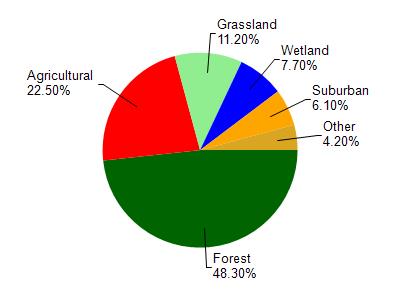
4 Miles
0 - 4
Cool-Cold Headwater, Cool-Warm Headwater
2023
Good
Sauk
No
No
No
Fish and Aquatic Life
Overview
Spring Brook is a small warm water tributary to Lake Delton. An impoundment on the stream
creates Blass Lake. The stream is considered a warm water forage fishery. Elevated
temperatures, low dissolved oxygen, low flow and limited in-stream habitat impact the
stream. These problems are most likely the result of nonpoint sources of pollution including
cropland erosion and barnyard runoff, hydrologic modification and urban stormwater runoff.
A 1999 macroinvertebrate survey indicated fair water quality.
Date 2002
Author Cynthia Koperski
Historical Description
Spring Brook is a small warm water tributary to Lake Delton. An impoundment on the
stream creates Blass Lake. A second impoundment, one-half mile above Blass Lake, has
been proposed. A biotic index sample from 1991 indicated good water quality at the site
of the proposed dam. The resulting impoundment, if created, likely will be eutrophic
with water quality conditions similar to those found in other impoundments in
southwestern Wisconsin (WDNR, 1991).
Date 1994
Author Surface Water Inventory Of Wisconsin
Condition
Wisconsin has over 84,000 miles of streams, 15,000 lakes and milllions of acres of wetlands. Assessing the condition of this vast amount of water is challenging. The state's water monitoring program uses a media-based, cross-program approach to analyze water condition. An updated monitoring strategy (2015-2020) is now available. Compliance with Clean Water Act fishable, swimmable standards are located in the Executive Summary of Water Condition in 2018. See also the 'monitoring and projects' tab.
Reports
Recommendations
Aquatic Plant Management Plan
update
Informational Meetings
Aquatic Plant Monitoring or Survey
summer plant survey will be conducted, voucher specimens of plant species present will be preserved
Management Goals
Wisconsin's Water Quality Standards provide qualitative and quantitative goals for waters that are protective of Fishable, Swimmable conditions [Learn more]. Waters that do not meet water quality standards are considered impaired and restoration actions are planned and carried out until the water is once again fishable and swimmable
Management goals can include creation or implementation of a Total Maximum Daily Load analysis, a Nine Key Element Plan, or other restoration work, education and outreach and more. If specific recommendations exist for this water, they will be displayed below online.
Monitoring
Monitoring the condition of a river, stream, or lake includes gathering physical, chemical, biological, and habitat data. Comprehensive studies often gather all these parameters in great detail, while lighter assessment events will involve sampling physical, chemical and biological data such as macroinvertebrates. Aquatic macroinvertebrates and fish communities integrate watershed or catchment condition, providing great insight into overall ecosystem health. Chemical and habitat parameters tell researchers more about human induced problems including contaminated runoff, point source dischargers, or habitat issues that foster or limit the potential of aquatic communities to thrive in a given area. Wisconsin's Water Monitoring Strategy was recenty updated.
Grants and Management Projects
Monitoring Projects
| WBIC | Official Waterbody Name | Station ID | Station Name | Earliest Fieldwork Date | Latest Fieldwork Date | View Station | View Data |
|---|
| 1295600 | Spring Brook | 10058575 | Spring Brook, Lyndon Road | 10/31/2023 | 10/31/2023 | Map | Data |
| 1295600 | Spring Brook | 10059821 | Spring Brook Pond | | | Map | Data |
| 1295600 | Spring Brook | 10016273 | Spring Brook Creek - 20 M Dwnstm Of Birchwood Rd Cros-Sing 3rd Site North Of Cth P | 5/22/1995 | 10/31/2023 | Map | Data |
| 1295600 | Spring Brook | 10009968 | Spring Brook - Spring Brook; 64 Meters Upstream From Highway 12 Culvert | 11/6/2003 | 9/20/2017 | Map | Data |
| 5029380 | Unnamed | 10059821 | Spring Brook Pond | | | Map | Data |
|

Watershed Characteristics
Spring Brook is located in the Dell Creek watershed which is 133.73 mi². Land use in the watershed is primarily forest (48.30%), agricultural (22.50%) and a mix of grassland (11.20%) and other uses (18.00%). This watershed has 231.97 stream miles, 193.10 lake acres and 4,715.88 wetland acres.
Nonpoint Source Characteristics
This watershed is ranked High for runoff impacts on streams, Medium for runoff impacts on lakes and High for runoff impacts on groundwater and therefore has an overall rank of High. This value can be used in ranking the watershed or individual waterbodies for grant funding under state and county programs.However, all waters are affected by diffuse pollutant sources regardless of initial water quality. Applications for specific runoff projects under state or county grant programs may be pursued. For more information, go to surface water program grants.
Spring Brook is considered a Cool-Cold Headwater, Cool-Warm Headwater under the state's Natural Community Determinations.
Natural communities (stream and lake natural communities) represent model results and DNR staff valiation processes that confirm or update predicted conditions based on flow and temperature modeling from historic and current landscape features and related variables. Predicated flow and temperatures for waters are associated predicated fish assemblages (communities). Biologists evaluate the model results against current survey data to determine if the modeled results are corect and whether biological indicators show water quaity degradation. This analysis is a core component of the state's resource management framework. Wisconsin's Riverine Natural Communities.
Cool (Warm-Transition) Headwaters are small, sometimes intermittent streams with cool to warm summer temperatures. Coldwater fishes are uncommon to absent, transitional fishes are abundant to common, and warm water fishes are common to uncommon. Headwater species are abundant to common, mainstem species are common to absent, and river species are absent.
Cool (Cold-Transition) Headwaters are small, usually perennial streams with cold to cool summer temperatures. Coldwater fishes are common to uncommon (<10 per 100 m), transitional fishes are abundant to common, and warm water fishes are uncommon to absent. Headwater species are abundant to common, mainstem species are common to absent, and river species are absent.